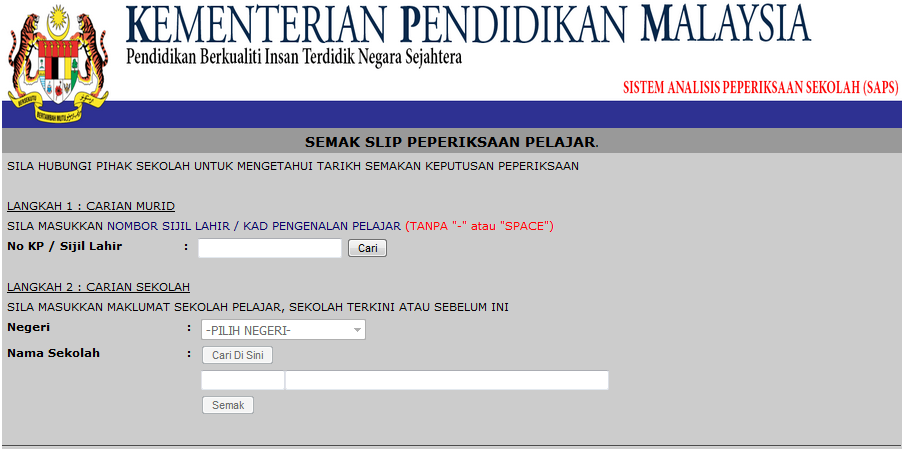Sistem Analisis Peperiksaan Sekolah (SAPS) Online Helps Parents To Monitor Their Children Academic Performance
It may not be easy for working parents to find the time to drop in at their children’s schools often to chat with their teachers and keep tabs on their progress.
To address this concern, the Education Ministry came up with a solution to allow parents to constantly keep in touch with their children’s academic progress and to have their school exam and test results at their fingertips at all times
The system, called SAPS or the “Sistem Analisis Peperiksaan Sekolah” is an interactive web-based database that covers 10,000 national primary schools and secondary schools.
Apart from encouraging schools to adopt an Information Communication Technology (ICT) culture, the Ministry, through this online tool, aims to measure students’ academic performance and enable better administration.
Teachers are required to key in student examination and test results into this database, allowing parents to have real-time access to their children’s academic results.
It is also made easy for parents who will only have to key in their children’s MyKad or MyKid number on the website, which will then automatically generate the exam slip with the test results on it.
The parent can decide to just view the results or even print it to keep for future reference.
The SAPS is among the initiatives of the Government Transformation Programme’s (GTP) Assuring Quality Education National Key Results Area (NKRA) which aims to provide quality educational opportunities for all regardless of race, religion or income.
Other areas of focus for the Education NKRA are improvements in literacy and numeracy rates, facilitating better administrative processes in schools, upskilling teachers, and identifying High Performing Schools.
The SAPS initiative, which is in line with the School Improvement Programme (SIP) under the Education NKRA, is a functional element that assists in providing school-level performance data.
It is seen as a critical component in helping principals set performance targets, prioritise school improvement actions and develop action plans.
“The implementation of the SAPS over the last three years has resulted in creating an atmosphere which is conducive to the teaching learning process, a stronger and more effective school administration system and certainly a more expedient way to identify weaker students and provide them with the immediate assistance needed to arrest the issue,” said the Ministry’s Performance and Delivery Unit (PADU) Executive Director Dr Noorliza Zakuan.
She said SAPS also offered analytical tools and features which equip teachers to improve themselves and thus, contribute towards improving the performance of their students.
The school principals, she said, could also use it to manage his or her teachers and school programmes in a more effective way.
She said it could also be used to facilitate discussion with the District Education Offices (PPD), as it would provide the needed justification to request for any form of support from the Ministry.
The SAPS helps by providing a more detailed student performance data in a timely manner.
It also helps the Ministry, State Education Department (JPN) and PPD to determine which schools require additional assistance through the standardized examination grading and calculations used for performance analysis.
“The implementation of SAPS has enabled the speed of transmission and data analysis for school information to be passed on to the Ministry in a more efficient and timely manner,” said Dr Noorliza.
While the schools still function in a traditional manner, she said, the SAPS was an effective and strategic system which could be used to transition schools to become more ICT-driven.
Admitting that there were still areas for improvement in the system, such as its accessibility online, she added that the Ministry was confident that the online reporting method was “here to stay” as it had helped significantly in improving administration.
“One of the ways that the SAPS has facilitated this transition is due to SAPS being inherently an online database system.
“Student data is easily transferable and if the student transfers to another school, the headcount strategy can be continued easily.
“Gone are the days where teachers need to dig up old documents whenever there are transfers.
“All the relevant data is now available online,” she added.
The online database also helps in assisting principals to plan a more effective and efficient use of the school’s resources.
This is accomplished by allowing principals to focus on the specific issues to tackle.
For example, instead of organising after-school tuition for all subjects, the principal can instead choose to only organise the extra classes for the few identified weak subjects.
The remaining resources could then be used to bring in external consultants to generate new ideas or help teachers and students on methods to master the weak subjects.
The SAPS can also help monitor the performance and progress of the schools in greater detail due to its cascading database.
In other words, this means that schools can monitor student performance data from not only the state-level, but also down to class and individual levels.
Allowing them access to all this information at any point of time, this web-based system also provides real-time data.
Last year, the SAPS made it as Malaysia’s No. 1 top trending search on Google (http://www.digitalnewsasia.com/digital-economy/malaysias-top-searches-has-a-surprise-or-two-google).
This shows that many parents are aware of and have utilised the new system to keep themselves up to date on their children’s performance in school.
Parents can monitor their children’s performance at school by visiting the SAPS portal at http://sapsnkra.moe.gov.my/ibubapa2/index.php and entering the student’s identification card number.
